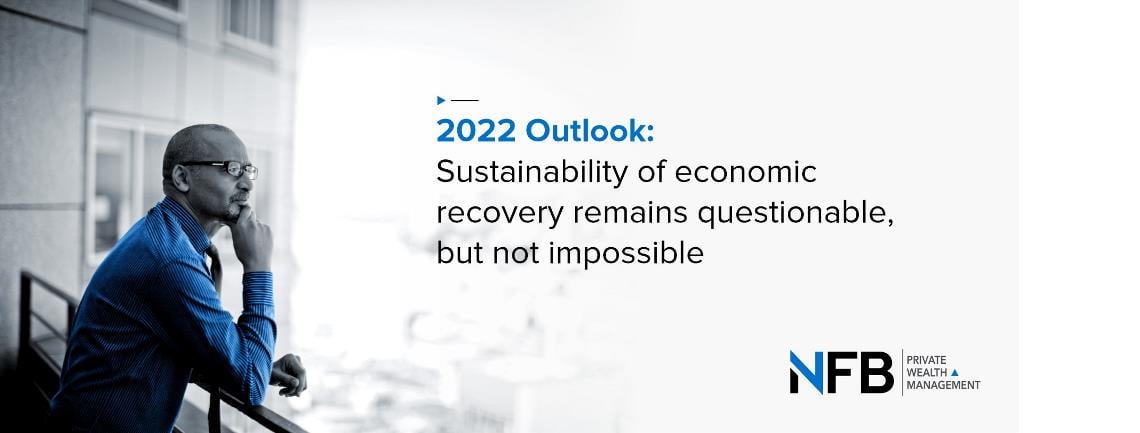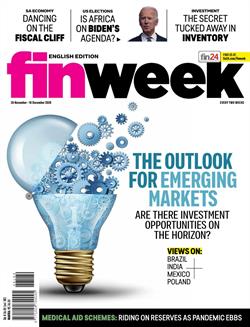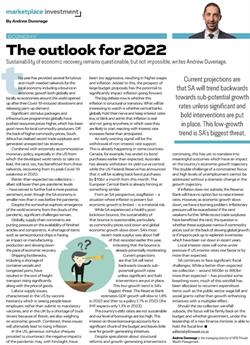The outlook for 2022
Sustainability of economic recovery remains questionable, but not impossible,

This year has provided a number of fortuitous and much-needed tail winds for the local economy including a bounce in economic growth both globally and locally as economies around the world opened up after their Covid-related induced slowdowns and pent-up demand was released.
Significant stimulus packages and infrastructure programmes globally have pushed resources prices higher which has been good news for local commodity producers. Off the back of higher commodity prices South Africa has realised record trade surpluses and generated unexpected tax revenue.
Combined with extremely accommodative monetary policy, especially in the US from which the developed world tends to take its lead, the Rand too has benefited from these tail winds, recovering from its peak Covid-weakness in 2020.
Better than expected tax collections – albeit still lower than pre-pandemic levels – have served to further fuel a more positive sentiment, even though the South African economy is smaller now than it was pre-Covid.
Despite the somewhat euphoric emergence of the world economy from the clouds of the pandemic, significant challenges remain both globally and locally.
Globally, supply chain constraints are putting pressure on the availability of finished articles and components. A shortage of items such as semiconductor chips is having an impact on manufacturing production and slowing down the pace of economic recovery.
Shipping bottlenecks, including a shortage of container vessels and congested ports, have resulted in the cost of freight transport rising significantly along with the price of goods.
Labour supply issues, characterised in the US by vaccine hesitancy which is seeing people leave employers rather that submit to mandatory vaccines, and in the UK by a shortage of truck drivers because of Brexit, is also weighing on economic growth. Combined, these issues will ultimately lead to rising inflation.
In the US, generous stimulus cheques provided to counteract the negative impacts of the pandemic may, with hindsight, have been too aggressive, resulting in higher wages and inflation. Added to this, the prospect of large budget proposals has the potential to significantly impact inflation going forward.
The big debate now is whether this inflation is structural or transitory. What will be interesting to watch is whether central banks globally hold their nerve and keep interest rates low, or blink and admit that inflation is real and not going anywhere, in which case they are likely to start reacting with interest rate increases faster than anticipated.
An early warning signal will be the withdrawal of non-interest rate support. This is already happening in some countries. Canada, for example, has ended its bond purchases earlier than expected; Australia has already withdrawn its Yield Curve Control; while the US Fed has announced that it will be tapering bond purchases by US$15 billion a month with immediate effect. The European Central Bank is already hinting at something similar.
From a South African perspective, stagflation – a situation where inflation is present but economic growth is limited – is a material risk.
While South Africa experienced a healthy post-lockdown bounce, the sustainability of that bounce is questionable, particularly as commodity prices cool down and global economic growth slows down. South Africa’s most recent trade surplus was about half of that recorded earlier this year, indicating that the bounce is already potentially moderating.
Current projections are that South Africa will trend backwards towards sub potential growth rates unless significant and bold interventions are put in place. This low growth trend is South Africa’s biggest threat. The SARB estimates GDP growth will slow to 1.8% in 2022 and then to a paltry 1.7% in 2023 (the IMF expects only 1.3% in 2023).
The country’s debt ratios are not sustainable and our level of borrowings are too high. The interest on those borrowings accounts for a significant chunk of the budget and leaves little over for growth-generating initiatives.
Despite speculation about structural reforms and growth generating interventions continuing, this has yet to translate into meaningful outcomes which have an impact on the country’s economic growth trajectory. The double challenge of a constrained fiscus and high levels of unemployment cannot be addressed without a dramatic change in the growth trajectory.
South Africa currently has one of the worst youth unemployment rates globally. This means there is a huge cohort of people who will enter middle age and retirement with very little in the way of skills and experience with the result that they will be a burden on the state from a significantly earlier age and for much longer.
If inflation does not subside the South African Reserve Bank will have no option but to raise interest rates. However, as economic growth slows down, we have a looming problem.
Inflationary pressure will be exacerbated if the Rand weakens further. While record trade surpluses have benefited the Rand, the question is whether these surpluses narrow if commodity prices cool on the back of slowing global growth, or if imports pick up to replenish inventories which have been run down in recent years.
Local interest rates will come under pressure if US interest rates rise faster or by more than expected.
South Africa continues to face significant fiscal challenges. While a better-than-expected tax collection – around R60 – R80 billion more than expected – has provided some breathing room, much of this windfall has been allocated to recurrent expenditure items such as the public sector wage bill and social grants rather than growth enhancing initiatives with a multiplier effect.
Should the tax collection windfall subside, the focus will be firmly back on the budget and whether government, under the leadership of a new finance minister, is able to hold the fiscal line.
|
This article was written exclusively for Finweek Magazine. It was published in the |
|
 |
 |






.jpg?sfvrsn=3ccd9277_0&size=350)

.png?sfvrsn=38ac0893_0&size=350)

































